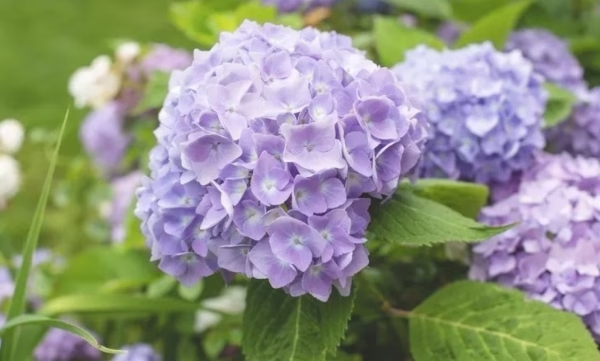
Hydrangea
Botanical Name
:
Hydrangea spp.
Plant Type
:
Flowering deciduous shrub
Seasons
:
Plant in early spring or fall; Blooms from late spring to early fall
Sun Level
:
Partial shade; at least 3-4 hours of direct sunlight per day
Ideal Soil Temperature for Planting
:
60–75°F (16–24°C)
Soil Type
:
Loamy, moist but well-drained with organic matter
Hardiness Zones
:
3–9 (USDA)
Germination
:
Seeds germinate in 14–21 days
P.H. Level
:
Slightly acidic to neutral (5.5–7.0)
Water/Irrigation
:
About 1–1.5 inches of water each week; prefers consistently moist soil
Fertilization
:
Use a slow-release balanced fertilizer with an NPK ratio of about 10-10-10 in early spring; water thoroughly before and after application
Habit
:
Rounded, spreading growth habit
Propagation
:
Seeds, cuttings, and division
Final Plant Height
:
3–15 ft
Spread
:
3–12 ft
Flowers
:
Pink, blue, white, purple (color varies with soil pH)
Attracts
:
Bees, butterflies, and hummingbirds
Uses
:
Cut flowers, border planting, foundation planting, container gardening, history of medicinal use
Companions
:
Hostas, astilbes, ferns, Japanese forest grass, alliums, anise hyssop, boxwood, begonias
Pruning
:
Prune after flowering; remove deadwood in early spring
Toxicity
:
Leaves and flower buds are mildly toxic to humans and pets if ingested
Pests
:
Aphids, spider mites, and scale insects
Diseases
:
Powdery mildew, leaf spots, and rust
Fun Fact
:
Fossil evidence shows that hydrangeas date back over 45 million years, making them nearly as ancient as dinosaurs
Additional Info
:
The color of Hydrangea flowers can change based on the pH level of the soil; acidic soil produces blue flowers, while alkaline soil produces pink flowers
Botanical Name
:
Hydrangea spp.
Plant Type
:
Flowering deciduous shrub
Seasons
:
Plant in early spring or fall; Blooms from late spring to early fall
Sun Level
:
Partial shade; at least 3-4 hours of direct sunlight per day
Ideal Soil Temperature for Planting
:
60–75°F (16–24°C)
Soil Type
:
Loamy, moist but well-drained with organic matter
Hardiness Zones
:
3–9 (USDA)
Germination
:
Seeds germinate in 14–21 days
P.H. Level
:
Slightly acidic to neutral (5.5–7.0)
Water/Irrigation
:
About 1–1.5 inches of water each week; prefers consistently moist soil
Fertilization
:
Use a slow-release balanced fertilizer with an NPK ratio of about 10-10-10 in early spring; water thoroughly before and after application
Habit
:
Rounded, spreading growth habit
Propagation
:
Seeds, cuttings, and division
Final Plant Height
:
3–15 ft
Spread
:
3–12 ft
Flowers
:
Pink, blue, white, purple (color varies with soil pH)
Attracts
:
Bees, butterflies, and hummingbirds
Uses
:
Cut flowers, border planting, foundation planting, container gardening, history of medicinal use
Companions
:
Hostas, astilbes, ferns, Japanese forest grass, alliums, anise hyssop, boxwood, begonias
Pruning
:
Prune after flowering; remove deadwood in early spring
Toxicity
:
Leaves and flower buds are mildly toxic to humans and pets if ingested
Pests
:
Aphids, spider mites, and scale insects
Diseases
:
Powdery mildew, leaf spots, and rust
Fun Fact
:
Fossil evidence shows that hydrangeas date back over 45 million years, making them nearly as ancient as dinosaurs
Additional Info
:
The color of Hydrangea flowers can change based on the pH level of the soil; acidic soil produces blue flowers, while alkaline soil produces pink flowers
Written by Nondiah Khalayi – https://www.linkedin.com/in/nondiah-khalayi/

